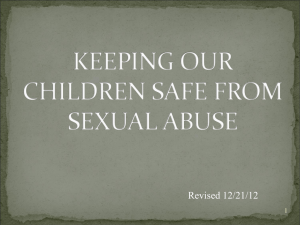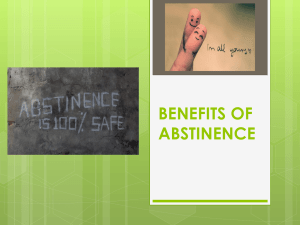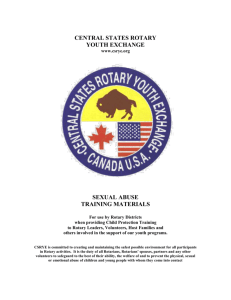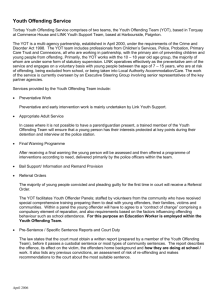Office of the Children`s Commissioner – Extracted from “If Only
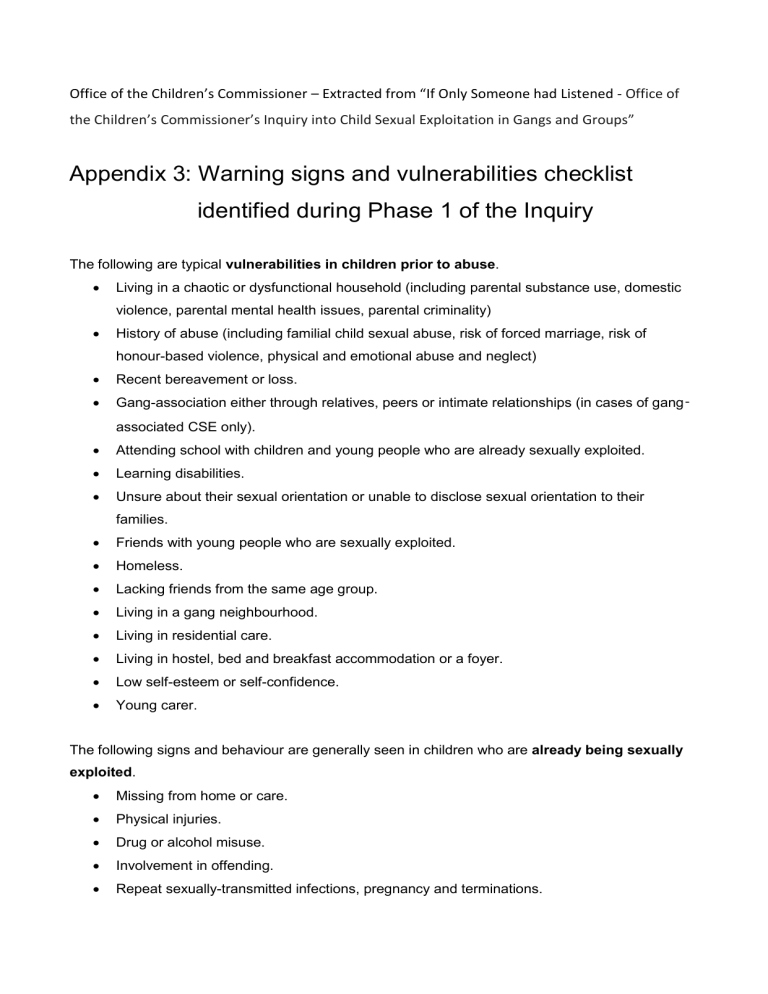
Office of the Children’s Commissioner – Extracted from “If Only Someone had Listened - Office of the Children’s Commissioner’s Inquiry into Child Sexual Exploitation in Gangs and Groups”
Appendix 3: Warning signs and vulnerabilities checklist identified during Phase 1 of the Inquiry
The following are typical vulnerabilities in children prior to abuse .
Living in a chaotic or dysfunctional household (including parental substance use, domestic violence, parental mental health issues, parental criminality)
History of abuse (including familial child sexual abuse, risk of forced marriage, risk of honour-based violence, physical and emotional abuse and neglect)
Recent bereavement or loss.
Gang-association either through relatives, peers or intimate relationships (in cases of gang ‑ associated CSE only).
Attending school with children and young people who are already sexually exploited.
Learning disabilities.
Unsure about their sexual orientation or unable to disclose sexual orientation to their families.
Friends with young people who are sexually exploited.
Homeless.
Lacking friends from the same age group.
Living in a gang neighbourhood.
Living in residential care.
Living in hostel, bed and breakfast accommodation or a foyer.
Low self-esteem or self-confidence.
Young carer.
The following signs and behaviour are generally seen in children who are already being sexually exploited .
Missing from home or care.
Physical injuries.
Drug or alcohol misuse.
Involvement in offending.
Repeat sexually-transmitted infections, pregnancy and terminations.
Absent from school.
Change in physical appearance.
Evidence of sexual bullying and/or vulnerability through the internet and/or social networking sites.
Estranged from their family.
Receipt of gifts from unknown sources.
Recruiting others into exploitative situations.
Poor mental health.
Self-harm.
Thoughts of or attempts at suicide.
Evidence highlighted in the interim report showed that any child displaying several vulnerabilities from the above lists should be considered to be at high risk of sexual exploitation. Professionals should immediately start an investigation to determine the risk, along with preventative and protective action as required.
However, it is important to note that children and young people without pre-existing vulnerabilities can still be sexually exploited. Therefore, any child or young person showing risk indicators in the second list, but none of the vulnerabilities in the first, should also be considered as a potential victim, with appropriate assessment and action put in place as required.
The following organisations and agencies need to take account of the above list and work together to identify children and young people showing the warning signs of, or who are vulnerable to, child sexual exploitation, and act accordingly.
Accident and Emergency departments
CAMHS services
Children’s Social Care (including family support/early intervention teams, child protection/duty and assessment teams, looked-after children teams, leaving care teams)
Drop-in clinics and community based health services
Drugs and alcohol misuse services
Educational institutions (including schools, pupil referral units, academies, private schools, special schools, and extra-curricular provision)
Fire Service
Gangs and serious youth violence projects
GP surgeries
GUM and family planning clinics
Housing (including foyers, hostels, refuges, bed and breakfast, and housing associations)
Midwifery and health visitors
Police (including neighbourhood policing, missing, safer schools officers, gangs and youth violence, organised crime, trafficking, child abuse investigation teams, sexual offences teams)
Residential children’s homes
Sexual Assault Referral Centres
Violence against women agencies (including rape crisis and refuge provision)
Youth Justice agencies (including youth offending services, secure training centres and youth offending institutions)
Youth service and specialist agencies working with children and young people (including mentoring services, those working with disabled children, LGBT children, BME children)
In order to identify children who show the above risk indicators, professionals could begin by bringing together data that is already collected, adopting a similar approach to that which has been used by the Inquiry to produce the CSEGG dataset. Data is not routinely collected on all of the risk indicators identified, but to assist with the risk assessment process we are publishing the list of indicators that the Inquiry used for the CSEGG dataset, and the data sources from which they were accessed.
Figure 17: CSEGG indicators, dataset and source
1.
Indicator Dataset
Missing from home or care Children reported missing
Or
Children reported to be ‘absconding’ or ‘breaching’
Source
Police
YOT data via
ASSET
2.
3.
4.
Victim of a sexual offence
Engagement in offending
Lacking friends from the same age group
Children reported as victims of rape
Young people known to youth offending services
Children lacking age appropriate friends
Police
YOT data via
ASSET
YOT data via
ASSET
5. Repeat sexually-transmitted infections, pregnancy and terminations
Children putting their health at risk YOT data via
ASSET
6.
7.
Or
Poor mental health
Recruiting others into exploitative situations
Living in a chaotic or dysfunctional household
(including parental substance misuse, domestic violence, parental mental health issues, parental criminality)
Or
History of abuse (including familial child sexual abuse, risk of forced marriage, risk of honour-based violence, physical & emotional abuse and neglect
Or
Children in care
Children displaying sexually inappropriate behaviour
YOT data via
ASSET
Children referred to as ‘children in need’
Or
Children ‘looked after’ under Both S31 and S20 Orders
Local Authority
Local Authority
Local Authority 8.
9.
Absent from school
Excluded from education
Children persistently absent from school
Children permanently excluded from school
10. Self-harm
Or
Thoughts of, or attempts at, suicide
Children who are self-harming or showing suicidal intent
Local Authority
PCT/CAMHS
11. Drug & alcohol misuse Children misusing drugs and/or alcohol
PCT/drug & alcohol team





